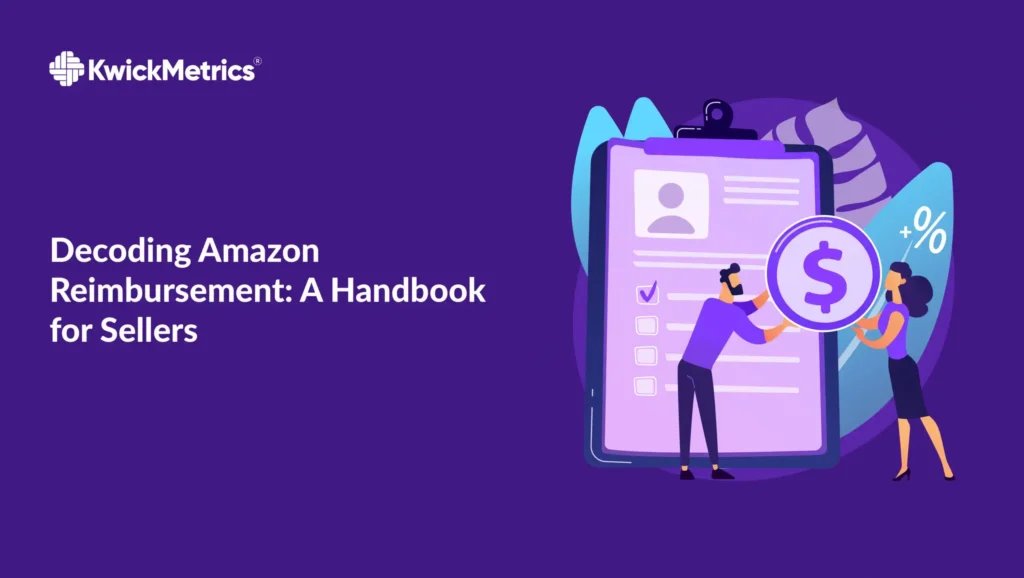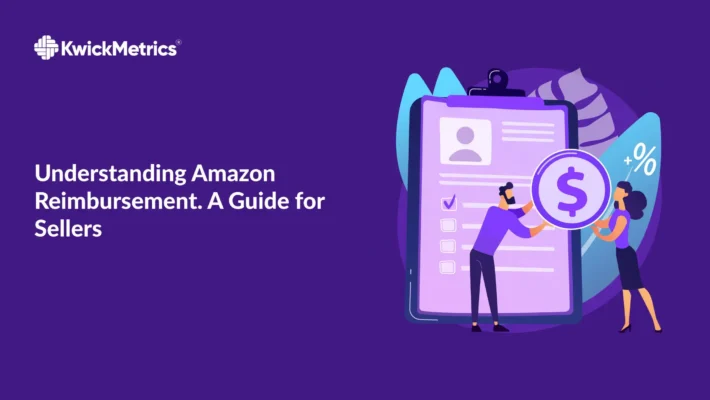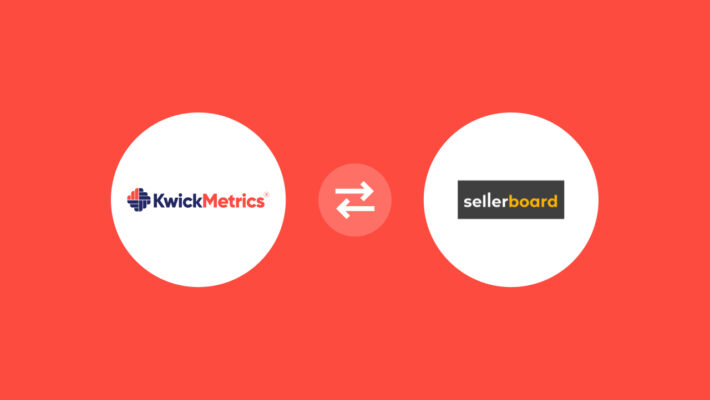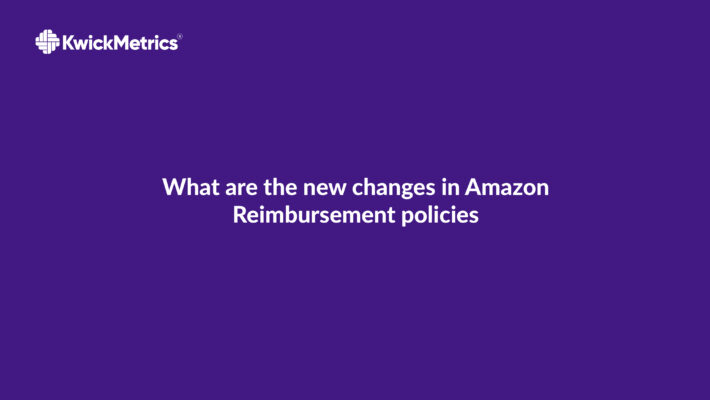Decoding Amazon Reimbursement: A Handbook for Sellers

Table of Contents
- Understanding Amazon Reimbursement
- The Crucial Importance of Amazon FBA Reimbursement for Sellers
- Check How Much Money You Deserve to Get Back!
- Types of Amazon FBA Reimbursements
- Navigating the Amazon Reimbursement Policy and Guidelines
- Try our Amazon Analytics Tool with a 14-day Free Trial!
- How KwickMetrics Enhances the Amazon Reimbursement Process?
- FAQs in Relation to Amazon Reimbursement
- Conclusion: Mastering Amazon Reimbursement for Seller Success
Ever found yourself in the midst of an Amazon labyrinth, lost between customer returns and FBA fees? That’s where understanding Amazon reimbursement becomes your compass. It can be as vital as air for Amazon sellers who are knee-deep in the turbulent waters of business.
You might think it’s all about inventory and sales – but let me tell you, there’s more to this tale. You see, when products get damaged or lost within those massive fulfillment centers, that’s when things start to feel a bit like a detective novel.
Your product is missing; now what? The plot thickens… This isn’t just another unsolved mystery. There are clues left behind – unfulfilled orders and returned items hinting at what may have happened.
Join me as we delve deeper into this Amazon reimbursement. We’ll learn together how to ensure you’re truly benefiting.
Understanding Amazon Reimbursement
For sellers using the Fulfillment by Amazon (FBA) service, one key element to understand is Amazon FBA reimbursement. When things go awry – like when a customer return goes missing in a fulfillment center or an item gets damaged before reaching the buyer – this mechanism kicks in. What is the purpose of Amazon reimbursement?
The Role of Amazon Reimbursement in FBA
Amazon FBA reimbursement serves as a lifeline for sellers entrenched in the vast ecosystem of Fulfilment by Amazon (FBA). It transcends a mere compensation mechanism; it’s a strategic process rectifying financial imbalances stemming from errors within the FBA system.
As sellers utilizing the Amazon reimbursement services, delegation of essential logistics functions—storage, shipping, and returns—is entrusted to the e-commerce giant. The necessity for reimbursement arises when entrusted tasks encounter discrepancies, leading to issues such as damaged inventory or overcharged fees.
The core essence lies in the sellers’ ability to file requesting amazon reimbursement claim for errors that Amazon hasn’t automatically addressed. It’s a pivotal process ensuring sellers are not only compensated for their financial losses but also guarantees the integrity of their profitability.
The Crucial Importance of Amazon FBA Reimbursement for Sellers
The Amazon FBA reimbursement process isn’t just a procedural step; it’s a strategic imperative for Amazon sellers. Its importance resonates across various facets of an Amazon seller’s operations, influencing financial stability, operational integrity, and long-term business sustainability. Amazon seller reimbursement plays a crucial role in maintaining a healthy bottom line and ensuring seamless operations for sellers on the platform.
Financial Safeguarding:
-
- Mitigating Financial Losses: The FBA reimbursement process serves as a robust financial safety net, shielding sellers from absorbing the brunt of financial losses triggered by incidents like misplaced, damaged, or improperly returned inventory. In the dynamic and sometimes unpredictable e-commerce landscape, this financial safeguard is instrumental in maintaining a healthy bottom line.
-
- Profitability Assurance: Seeking FBA reimbursement service is synonymous with safeguarding profitability. Sellers invest considerable effort and capital into their operations, and the reimbursement process ensures that the returns on this investment are not compromised. It becomes a proactive strategy to secure the fruits of their hard work and mitigate potential revenue drains.
Operational Integrity:
-
- Ensuring Operational Smoothness: The Amazon FBA Reimbursement process plays a pivotal role in maintaining operational smoothness. Addressing errors promptly prevents disruptions that could ripple across various facets of a seller’s operations. This ensures that the fulfilment and delivery mechanisms continue to function seamlessly.
-
- Trust and Reliability: A reliable reimbursement process instils trust in sellers regarding the operational integrity of the platform. Sellers can confidently engage in their business activities, knowing that Amazon has mechanisms in place to rectify errors. This trust is a cornerstone for building long-term, mutually beneficial relationships between sellers and the e-commerce giant.
Check How Much Money You Deserve to Get Back!
Business Sustainability:
-
- Long-Term Viability: Navigating and mastering the reimbursement process is more than a reactive measure; it’s a strategic investment in long-term business viability. In the intensely competitive e-commerce landscape, sellers who understand and leverage reimbursement effectively position themselves for sustained success.
- Risk Mitigation: The reimbursement process serves as a potent risk mitigation strategy. Unforeseen errors, if left unaddressed, have the potential to escalate into long-term challenges that could jeopardize the sustainability of the business. By proactively engaging with the reimbursement process, sellers mitigate these risks, ensuring that isolated incidents don’t snowball into significant operational hurdles.
Key Takeaway:
Amazon's reimbursement process. It's not just about getting back the money for lost or damaged goods, but it also ensures financial stability and business integrity for sellers. So, accurate tracking tools like KwickMetrics are essential to prevent profit loss and maintain trust in Amazon’s operations.
Types of Amazon FBA Reimbursements
Navigating the Depths Amazon’s intricate fulfilment network, handling millions of products daily, is prone to occasional operational hiccups that can impact sellers financially. Understanding the diverse types of Amazon FBA reimbursements is essential for sellers to navigate these complexities effectively.
-
- Inventory Lost: Compensation for items lost within Amazon’s fulfilment centers or during transit.
- Inventory Damaged: Reimbursement for items damaged within Amazon’s storage facilities or during transportation.
- Inventory Destroyed: Compensation for inventory mistakenly disposed of in Amazon’s Fulfilment Centre.
- Carrier Damaged: Reimbursement for items damaged by the carrier during transit.
- Incorrect Refund: Compensation for Amazon errors in refund calculations; apply for reimbursement if owed more.
- Missing Shipments: Compensation for lost or undelivered shipments; file a claim for reimbursement.
- Excess Shipments: Refund for items shipped to Amazon in excess of the quantity intended.
- Return Lost: Reimbursement for items lost during the return process.
- Replacement Lost: Compensation for items lost when a replacement is sent to the customer.
- Weight and Dimension Fees Overcharged: Refund for orders where weight or dimensional fees were charged incorrectly.
- Commission/Referral Fees Overcharged: Compensation for orders where commission fees were overcharged.
- Return Restocking Fee Issue: Reimbursement for orders returned over 30 days without the required 20% restocking fee.
- Wrong Item Returned: Compensation for situations where an incorrect item is returned and scanned into your inventory.
- Sellable Inventory Mistakenly Disposed: Reimbursement for mistakenly disposed-of sellable inventory in Amazon’s Fulfilment Centre.
- Inventory Removal Discrepancy: Compensation occurs when the quantity or condition of inventory that Amazon removes is different from what was requested by the seller.
- Item Lost in Transit: Items may be lost while in transit at Amazon’s fulfillment centers during removal process.
- Mistakes: Typos or errors while removing from inventory as requested by the seller.
- Damaged items: Items may be damaged during shipping or while being counted in the fulfillment center when asked for removal by the seller
- Chargeback Not Reimbursed: Compensation for chargebacks issued by Amazon that were not reimbursed.
- Inaccurate Reimbursement (Units and Amount): Refund for cases where Amazon reimbursed for fewer units or a lower amount than deserved.
- Missing Reimbursements: Compensation for situations where Amazon did not fully reimburse the expected amount based on the item’s value.
Key Takeaway:
Amazon FBA reimbursements offer a safety net for sellers dealing with lost or damaged inventory. If your goods go missing in transit or at fulfillment centers, Amazon compensates you. Similarly, if your items suffer damage while under Amazon's care, FBA refunds are there to cushion the blow. Mastering these reimbursement types is crucial for safeguarding your bottom line.
Navigating the Amazon Reimbursement Policy and Guidelines
The Amazon Reimbursement FBA Policy serves as the cornerstone for sellers seeking compensation for goods that encounter unfortunate fates while under Amazon’s custody. However, delving into this policy requires a nuanced understanding of its various facts.
Navigating Eligibility Requirements:
The journey into Amazon reimbursement begins with understanding and meeting specific eligibility requirements. Sellers must adhere to stringent criteria to qualify for compensation:
-
- Lost or Damaged Items: If items sent through FBA are lost or damaged in Amazon facilities or by an Amazon-operated carrier, the reimbursement process kicks in. The damaged item is replaced for a pristine customer experience, or the seller is reimbursed, crucial for maintaining confidence and financial stability.
-
- Price Indicators: The determination of reimbursement amounts is a meticulous process involving various price indicators. Amazon scrutinizes factors such as the seller’s current list price, the average price over specific timeframes (90 days and 365 days), and the average current list price set by other sellers for the same item. This multifaceted approach ensures a fair and accurate reimbursement calculation.
-
- Additional Information: Transparency is key in the reimbursement process. Amazon reserves the right to request supplementary information or documentation to facilitate an accurate and justified reimbursement. Sellers should be prepared to provide the necessary details to support their claims.
Try our Amazon Analytics Tool with a 14-day Free Trial!
Unveiling the Eligibility Criteria:
To embark on the path of an Amazon reimbursement claim, sellers must meet specific eligibility criteria. These criteria serve as the foundation for a successful reimbursement request:
-
- Utilization of FBA Services: Participation in the Amazon FBA program is a fundamental requirement for sellers seeking reimbursement. This criterion ensures that the fulfilment of orders, and consequently, any potential issues like damage or loss, occurs within the parameters of Amazon’s FBA services.
- Compliance with Amazon Requirements: The products slated for reimbursement must align with Amazon’s extensive list of requirements and restrictions. From packaging specifications to product condition, strict adherence to these guidelines is essential to qualify for reimbursement.
- Accurate Input of Shipping Plans: Precise documentation is crucial in the reimbursement process. Sellers are required to input accurate shipping plans that provide a detailed and comprehensive description of their inventory items along with the corresponding quantities. This precision aids in creating a transparent record of the dispatched items.
- Non-Defective Items: The realm of Amazon reimbursement is reserved for non-defective items. Defective items fall under different processes, such as returns or warranty claims. Only items meeting Amazon’s standards of quality are eligible for reimbursement, reinforcing the platform’s commitment to customer satisfaction.
Key Takeaway:
Consider Amazon's reimbursement policy as a challenging treasure map. With some dedication and attention, you can certainly get the hang of it. To file claims, you must meet specific eligibility requirements – this could be for inventory lost or damaged during transit or within fulfillment centers. But keep in mind that it's not just about knowing when you're eligible for a refund - understanding how much Amazon should pay back to you is equally crucial. Don't forget to use helpful tools.
How KwickMetrics Enhances the Amazon Reimbursement Process?
Navigating the intricacies of Amazon FBA reimbursement can be overwhelming, but third-party solutions like KwickMetrics provide invaluable assistance. Here’s how KwickMetrics enhances the reimbursement process:
• Real-time Reporting System: KwickMetrics offers a real-time reporting system and dashboard that provides insights into eligible reimbursement amounts. This empowers sellers with up-to-date information to make informed decisions.
• Expiration Timeframes: The platform highlights expiration timeframes for reimbursement claims, ensuring that sellers prioritize claims with impending deadlines. This proactive approach prevents overlooking potential refunds.
• Efficient Claims Management: KwickMetrics streamlines claims management by providing a comprehensive overview of reimbursement eligibility. Sellers can efficiently track and manage claims, optimizing the entire reimbursement process.
In the dynamic landscape of e-commerce, tools like KwickMetrics become essential allies for FBA sellers, ensuring they maximize their reimbursement potential and maintain a robust financial standing.
Key Takeaway:
Mastering the Amazon reimbursement process is crucial for every FBA seller. To start, log into your Seller Central account and file a precise claim with evidence within 18 months of the issue. Remember, mistakes can happen at fulfillment centers like lost or damaged goods - these are grounds for refunds.
FAQs in Relation to Amazon Reimbursement
What is FBA inventory reimbursement?
FBA Inventory Reimbursement is a key feature of Amazon’s FBA program, providing financial compensation to sellers for items lost or damaged within Amazon storage facilities or during transit.
When should I consider filing for Amazon Reimbursement?
File for Amazon Reimbursement when you encounter problems like lost or damaged inventory, incorrect refund calculations, or any discrepancies that may result in financial losses.
How do Amazon reimbursements work?
If items are lost or damaged in an FBA warehouse, Amazon reimburses you. They also cover customer returns not received within 45 days.
Does Amazon reimburse for customer damaged?
Absolutely. If a product gets wrecked during shipping to the customer or while stored at an FBA center, they got your back financially.
Conclusion: Mastering Amazon Reimbursement for Seller Success
Mastering Amazon FBA reimbursements is not just about correcting financial discrepancies; it’s a strategic imperative for sellers in the dynamic e-commerce landscape. By understanding the depths of amazon reimbursement types, the nuances of Amazon’s reimbursement policy, and the role of tools like KwickMetrics, sellers can navigate this process with confidence.
In the next part of our series, we will delve even deeper, exploring specific scenarios and best practices for filing successful reimbursement claims. Stay tuned for actionable insights that will empower you to safeguard your financial interests and thrive as an Amazon FBA seller.



